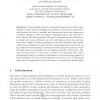Free Online Productivity Tools
i2Speak
i2Symbol
i2OCR
iTex2Img
iWeb2Print
iWeb2Shot
i2Type
iPdf2Split
iPdf2Merge
i2Bopomofo
i2Arabic
i2Style
i2Image
i2PDF
iLatex2Rtf
Sci2ools
MIRRORBOT
2005
Springer
2005
Springer
Spatial Representation and Navigation in a Bio-inspired Robot
Abstract. A biologically inspired computational model of rodent representation–based (locale) navigation is presented. The model combines visual input in the form of realistic two dimensional grey-scale images and odometer signals to drive the firing of simulated place and head direction cells via Hebbian synapses. The space representation is built incrementally and on-line without any prior information about the environment and consists of a large population of location-sensitive units (place cells) with overlapping receptive fields. Goal navigation is performed using reinforcement learning in continuous state and action spaces, where the state space is represented by population activity of the place cells. The model is able to reproduce a number of behavioral and neurophysiological data on rodents. Performance of the model was tested on both simulated and real mobile Khepera robots in a set of behavioral tasks and is comparable to the performance of animals in similar tasks.
| Added | 28 Jun 2010 |
| Updated | 28 Jun 2010 |
| Type | Conference |
| Year | 2005 |
| Where | MIRRORBOT |
| Authors | Denis Sheynikhovich, Ricardo Chavarriaga, Thomas Strösslin, Wulfram Gerstner |
Comments (0)

